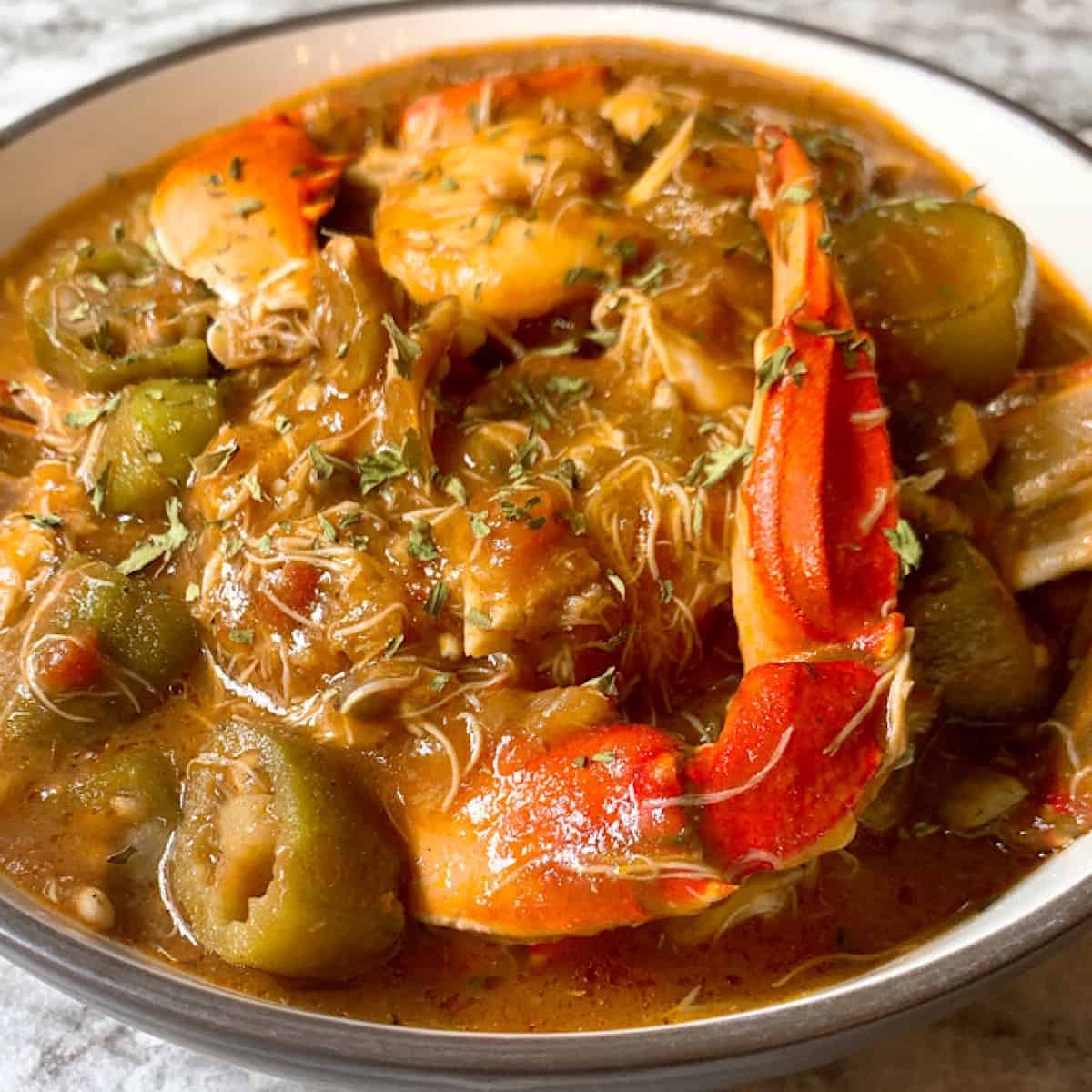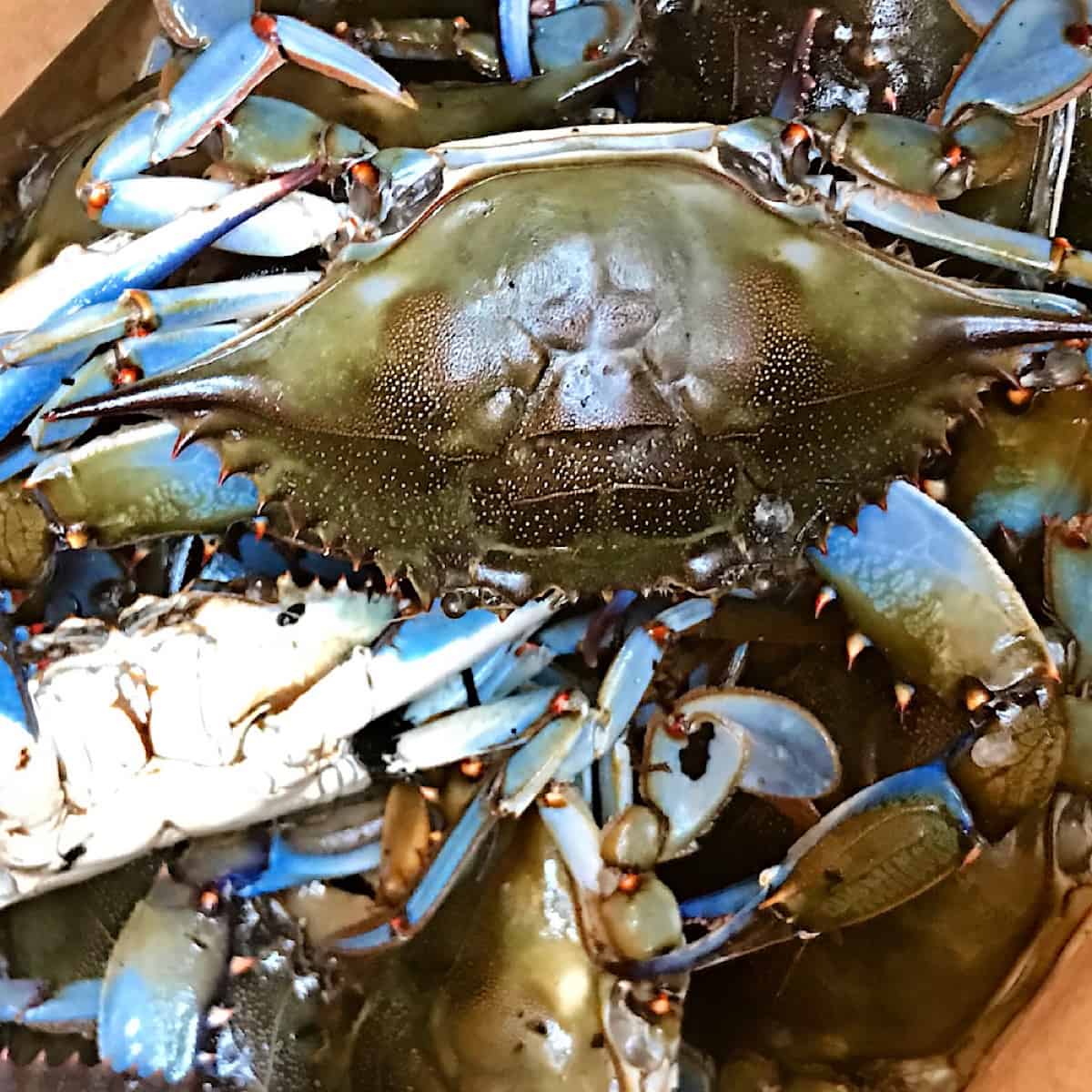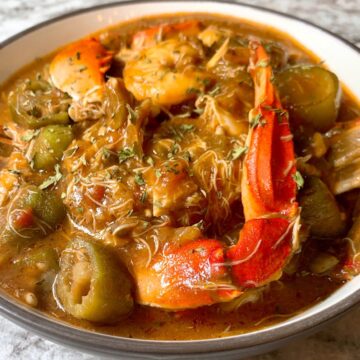Welcome to our family's favorite—Best Shrimp and Crab Gumbo Recipe! This Louisiana-style Creole seafood dish brings back cherished memories of our Mamaw making a huge pot for our family. We’d even catch fresh blue crabs at the marina!
This slightly adapted family recipe is a true Southern classic. If you love fresh seafood, you'll also enjoy our popular Fried Grouper Cheeks, Bay Scallop Pasta, and Deep Fried BBQ Blue Crabs!

Save This Recipe 💌
Gumbo, a staple dish in New Orleans, is a rich and flavorful soup-like concoction known for its diverse combination of ingredients. It draws influences from African, French, Spanish, and Native American cuisines, making it a true representation of the multicultural melting pot that is New Orleans.
A traditional gumbo typically includes a roux, the holy trinity of onions, celery, and bell peppers, and a variety of proteins such as shrimp, crab, and andouille sausage. The key to a great gumbo lies in the depth of flavors achieved by creating a perfect dark brown roux and patiently simmering the ingredients together.
Why We Love This Recipe
- It's Flavorful: Packed with the authentic flavors of the Deep South, this dish combines a perfect blend of succulent shrimp and sweet lump crab meat. If you want an easy seafood dinner option, try our Cajun Shrimp and Veggie Sheet Pan, Peel and Eat Shrimp, or our Stovetop Boiled Crawfish.
- It's a Crowd-Pleaser: Be prepared to impress your family and friends—just like with our Cajun Roasted Chicken and Cajun Fried Chicken, more Louisiana favorites!
- It's Traditional: This shrimp and crab gumbo recipe stays true to its Southern roots, embracing the traditional flavors and techniques passed down through generations.
- It's Comforting: Each spoonful of this shrimp and crab gumbo creates a truly satisfying and soul-warming meal.
Seafood Gumbo Ingredients
The key to a rich, flavorful gumbo starts with the right ingredients.
- Live Blue Crabs: Fresh seafood is the best! Of course, if no live crabs are in your area, or you just want to make this recipe a little quicker, you can buy frozen gumbo crabs at your local grocer or seafood market.
- Jumbo Lump Crab Meat: Sweet and tender, lump crab meat brings richness to the dish. We prefer to buy this at our local seafood market, picked fresh.
- Jumbo Shrimp with Heads: Succulent and briny, shrimp adds a delicate seafood flavor to the gumbo. The shrimp heads will provide a flavorful base for the gumbo, intensifying the seafood taste. Have excess shrimp on hand and need some ideas? Try this Old Bay Shrimp Salad on a Bed of Greens.
- Peeled Plum Tomatoes: We like the San Marzano variety.
- Chicken Broth: Enhances the overall depth of flavors in the gumbo.
- Onion: Finely chopped for maximum flavor.
- Vegetable Oil: Used for sautéing and creating the roux.
- Bisquick: A baking mix that is commonly used in the South. It creates a dark and flavorful roux that serves as the base for the gumbo.
- Okra: This ingredient serves as a thickener (along with the roux).
- Bay Leaves: Infuse the gumbo with a subtle herbal note.
- Cajun Seasoning: A blend of spices that adds a bold and savory kick to the gumbo.
- Cayenne Pepper: Cayenne pepper adds a subtle kick of heat to the gumbo
- Water: Water is added to the gumbo as needed to adjust the consistency and ensure the perfect balance of flavors.
- Salt and Pepper: (to taste)
- Rice (Optional): While it stirs up controversy, this dish is often served over long grain rice.
- Parsley: For garnish
A full ingredient list with exact measurements can be found in the recipe card below.
How to Make the Best Shrimp and Crab Gumbo
Bringing this Louisiana gumbo to life is all about layering flavors. This is how to get perfect gumbo every time.

Step One: Prepare the Shrimp Stock
Begin by sautéing the shrimp heads and shells in oil over medium heat for approximately 3-4 minutes. This will help release their flavors. Add chicken broth and bay leaves to the pan, then reduce the heat to low and let the mixture simmer.
While the seafood broth simmers, proceed to boiling and cleaning the crabs. To extract maximum flavor, gently press the shrimp heads against the pan. Once the broth is done, strain it using a fine-mesh strainer to remove the shells.
Step Two: Prepare the Crabs
Boil the crabs in a large pot of water for about 3-5 minutes until they are cooked. Once the crabs have cooled down, clean them by removing the large claws, top shell, gills, and apron. Set aside the claws and gumbo crab meat for later use, and discard the rest. You can find detailed instructions on how to clean a blue crab at Wikihow.com Clean a Blue Crab.
Step Three: Prepare the Roux
In a large pot, combine Bisquick and oil to make the roux. Stir continuously over medium heat until the roux reaches a dark chocolate color. This process will take approximately 20-30 minutes, so it's important to stay attentive and avoid leaving the roux unattended. When the roux turns dark brown, add the diced onions to infuse additional flavor. Have the seafood broth and tomato sauce ready to pour into the pot immediately after the roux is finished.
Step Four: Prepare the Gumbo
To make the seafood gumbo, add the blended peeled plum tomatoes, hand-crushed peeled plum tomatoes, seafood broth, gumbo crabs, okra, and spices to the pot with the roux. Stir everything together until well combined. If needed, add some water to adjust the consistency of the gumbo. Let the gumbo simmer on low heat for 20-30 minutes to allow the flavors to meld together. During the final stage, add the seasoned shrimp and jumbo lump crab meat to the pot and cook until they are fully cooked through.
Step Five: Serve and Store
Serve the seafood gumbo while it's still warm, ideally accompanied by a serving of rice. For an extra touch of freshness, garnish with some fresh parsley, if desired.
If you have any leftovers, store the seafood gumbo in an airtight container in the refrigerator for 2-3 days. Alternatively, this dish can be frozen for future enjoyment.
Substitutions & Variations
- Crabs: Frozen gumbo crabs can be used in place of live blue crabs.
- Shrimp: If you prefer, you can substitute the shrimp with other seafood options like crawfish or even a combination of different seafood. Additionally, you can replace the blue crabs with other crab varieties.
- Spice: Cayenne pepper can be substituted for a milder spice or left out completely to make this gumbo less spicy. If you don't have Cajun seasoning on hand, you can create your own blend using a mixture of paprika, garlic powder, onion powder, dried thyme, dried oregano, cayenne pepper, and black pepper.
How Can I Customize this Recipe?
- Add-ins: Many people like to add cajun andouille sausage to gumbo. If you can't find andouille sausage, you can use smoked sausage or kielbasa as a substitute. The smoky flavors will still complement the gumbo.
- Vegetarian: For a vegetarian version, omit the seafood and andouille sausage. Instead, you can use a medley of vegetables like bell peppers, celery, carrots, and mushrooms to create a hearty and flavorful gumbo. Add extra spices and seasonings to enhance the flavors.
- Chicken and Sausage: If you're not a fan of seafood, you can make a chicken and sausage gumbo by substituting the shrimp and crab with boneless, skinless chicken thighs or breasts.
Expert Tips for Success
👩🍳Jami's Pro Tips: Want to take this recipe to the next level? Check out my expert tips below for the best flavor, texture, and more meal prep hacks!
✔️ DO Go slow. Patience is key when making the roux. It's crucial to achieve the right color and flavor, so be patient and stir continuously to prevent burning.
✔️ DO Use fresh seafood to ensure the best taste. This will enhance the overall flavor and texture of the gumbo.
✔️ DO Taste the gumbo as it cooks and adjust the spices accordingly. Add more cayenne pepper or hot sauce if you prefer a spicier kick.
✔️ DO Consider making gumbo a day ahead to allow the flavors to blend together. When reheating, gently warm the gumbo on the stovetop over low heat, stirring occasionally.
Storage
Shrimp and crab gumbo is even better the next day as the flavors blend together. Allow it to cool completely before storing it in an airtight container in the refrigerator. It can be refrigerated for 2-3 days.
Can You Freeze Gumbo?
This dish is freezer-friendly. Let it cool completely before transferring it to airtight containers or freezer bags. Make sure to leave some headspace to allow for expansion during freezing. Label the containers with the date and contents for easy reference. Seafood gumbo can be frozen for up to 3 months.
Recipe FAQs
Roux is equal parts flour and fat and it is used as a thickening agent for soups, stews, etc. Darker roux is commonly used in Creole and Cajun cuisine because it adds tremendous flavor.
Seafood gumbo contains roux and it is typically served over a small amount of rice. Seafood jambalaya is made with rice and contains much less liquid. Many people do not add roux to seafood jambalaya.
These small crabs are primarily used to flavor soups, stews, and gumbo. You can eat the meat inside the shell, but it takes a little work. Larger blue crabs contain more meat.
Yes, you can substitute okra with other vegetables if you're not a fan or have difficulty finding it. Some suitable alternatives include sliced bell peppers or diced zucchini.
Steamed rice, cornbread, french bread, collard greens, or a nice side salad would pair well with crab and shrimp gumbo.
Blue crabs can be found in coastal areas and are often available at seafood markets or specialty seafood stores. Depending on your location, they may be available both live and pre-cooked.
The best rice for gumbo is typically long-grain white rice. Its light and fluffy texture provides a perfect complement to this dish. Long-grain rice tends to stay separate and doesn't clump together, allowing the gumbo to be enjoyed with each grain of rice individually.
Related
- Cajun Andouille Sausage and Shrimp Sheet Pan
- Grouper Cheeks Recipe
- Simple Bay Scallops with Pasta and Lemon Garlic Sauce
- Sartin's Signature Deep Fried BBQ Blue Crabs
More Seafood Recipes You'll Love ♥️
Did You Like Seafood Gumbo Recipe?
- Leave a ⭐️⭐️⭐️⭐️⭐️ Star Rating if think this crab and shrimp gumbo is awesome!
📖 Recipe

Best Shrimp and Crab Gumbo Recipe
Ingredients
- 12 live blue crabs
- 16 ounces jumbo lump crab meat
- 2 pounds jumbo shrimp with heads on fresh
- 2 28 ounce cans peeled plum tomatoes San Marzano variety
- 4 cups chicken broth
- 1 medium onion finely chopped
- 1 cup vegetable oil
- 1 cup Bisquick
- 2 8 ounce bags okra (frozen cut)
- 2 bay leaves
- 1-2 tablespoons cajun seasoning or to taste
- 1 teaspoon cayenne or to taste
- 1 cup water optional to thin sauce
- 1 teaspoon salt and freshly cracked pepper or to taste
Instructions
- Begin by dicing the onion and peeling the shrimp, reserving the shells. Place the peeled shrimp in the refrigerator until ready to use.
- Prepare the shrimp stock by heating olive oil in a pan over medium heat. Add the shrimp shells, including the heads, and bay leaves. Sauté for 3-4 minutes until fragrant. Pour in the chicken broth, reduce the heat to low, and let it simmer while you prepare the crabs.
- While the shrimp stock simmers, bring a pot of water to a boil. Add the live crabs and boil them for 3-5 minutes. Drain and let them cool.
- Clean the blue crabs by removing the large claws, top shell, gills, and apron. Set aside the large claws and cleaned gumbo crabs to be added later.
- Blend one can of tomatoes and set aside.
- Stir the shrimp stock and press down on the shells to extract the juices. Strain the shrimp stock, ensuring to remove all shells. Set aside both the tomato sauce and seafood broth for later use.
- In a large pot or dutch oven, combine Bisquick and oil to make the roux. Stir continuously over medium-low heat until the roux reaches a dark chocolate color, approximately 20-30 minutes. Do not leave the roux unattended to prevent burning. Add the finely chopped onion when the roux turns dark brown.
- Quickly pour the seafood broth and blended tomatoes into the roux. Add the sliced okra and crabs. Hand-squeeze the remaining can of tomatoes and add them to the gumbo along with the tomato sauce. Season with salt, pepper, and your favorite Cajun seasoning. Cook on low heat for 20-30 minutes, adding water if needed to adjust the consistency.
- During the last 5-10 minutes of cooking, add the seasoned shrimp and jumbo lump crab meat. Cook until the shrimp are pink and fully cooked.
- Serve the classic seafood gumbo warm. Optionally, serve it with rice. Garnish with fresh parsley. Enjoy!
Save This Recipe 💌
Notes
-
- Crabs: Frozen gumbo crabs can be used in place of live blue crabs.
-
- Shrimp: If you prefer, you can substitute the shrimp with other seafood options like crawfish or even a combination of different seafood. Additionally, you can replace the blue crabs with other crab varieties.
-
- Spice : Cayenne pepper can be substituted for a milder spice or left out completely to make this gumbo less spicy. If you don't have Cajun seasoning on hand, you can create your own blend using a mixture of paprika, garlic powder, onion powder, dried thyme, dried oregano, cayenne pepper, and black pepper.









SHANNA says
Delicious!!!
Justin says
From Cajun to Creole to Gullah...there are many interpretations of a good gumbo recipe and this one hits the spot!
The flavor is on point! Easily a family favorite in our house. Thank you!
Alan says
Tomato don’t go I. Gumbo period
Jami Powell says
Alan, that’s a popular debate! Traditionally, Creole gumbo (seafood or shellfish) often includes tomatoes. We love us a good Cajun gumbo, too. 😋 It’s all about the style and flavor you prefer!
Nancy Bullard says
This is the BEST gumbo recipe EVER! I hardly ever try a gumbo recipe because I had given up. I didn’t want to waste my time or money anymore. When I read the ingredients I was willing to give it a try. I am so glad! It is exactly what I was looking for! Thank you so much! I will definitely share it!!! DELICIOUS!!!
Gail L Sanders says
I was disappointed that the trinity (bell peppers, onion and celery) were mot used. As well as garlic, otherwise, it's very close to what I know as Gumbo
Jami Powell says
Thank you for sharing your thoughts, Gail! This recipe is one that’s actually very dear to us. It comes from our grandmother (Mamaw) and has been a favorite in our family for years.